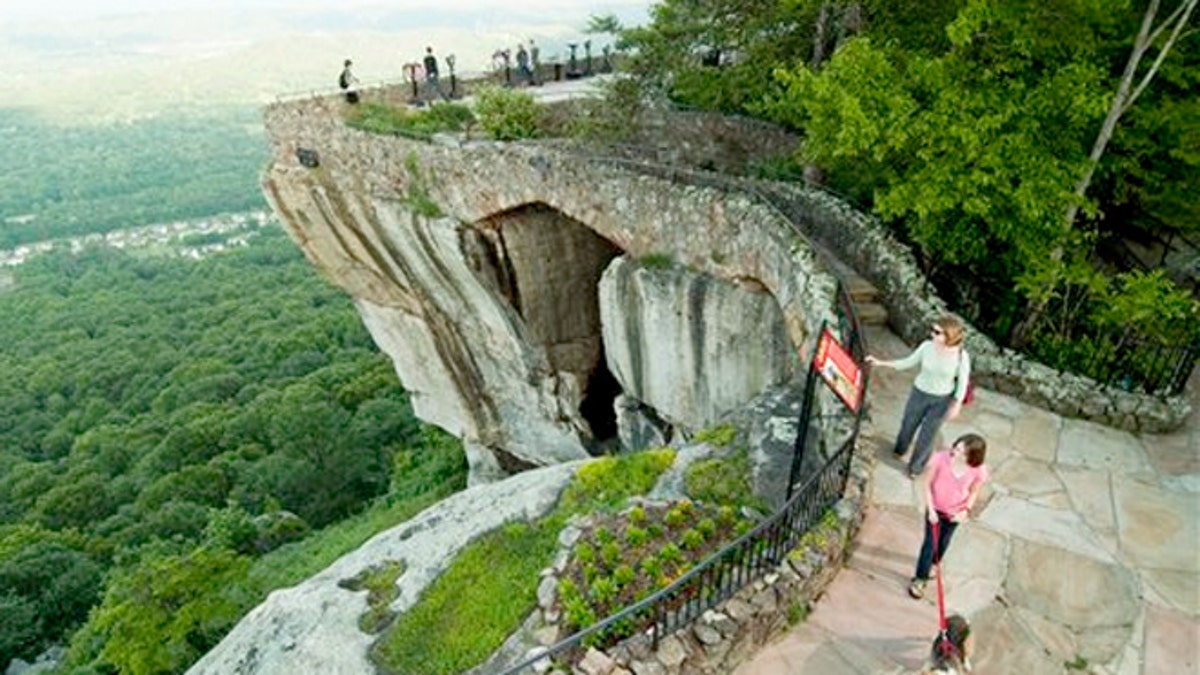
Lover's Leap, one of the well-known scenic spots along the Enchanted Trail. (AP)
It's been advertised on barns and billboards across much of the country. It's a natural wonderland with a rock formation called "fat man's squeeze." And it's been mentioned in a country song.
Rock City, a cultural and scenic capstone near Chattanooga with endurance like few other tourist attractions, is celebrating its 80th anniversary.
About 400,000 visitors annually come to see the 200-million-year-old rock formations, enjoy scenic vistas and walk among 400 native plant species on 90-minute self-guided tours along a stone path.
On the site are a 100-foot high waterfall, a 1,000-ton balancing rock, a swinging bridge and the "fat man's squeeze" challenging visitors to maneuver between imposing boulders. For the youngsters, there are concrete gnomes, a rock climbing wall and statues of storybook characters.
The 14-acre family-owned attraction atop Lookout Mountain, Ga., six miles from downtown Chattanooga, has survived the Great Depression, World War II, area pollution and the recent Great Recession.
"We combine natural beauty with incomparable gardens, views and wonders," says Andrew Kean, Rock City's president and chief operating officer.
And it's used an unconventional advertising campaign without corporate muscle: Barns, billboards and bird houses proclaim the commanding invitation "See Rock City."
"We've had a phenomenal amount of outdoor advertising," Kean says.
Much of the promotion focuses on the intrigue that on a clear day, visitors can see Tennessee, Kentucky, Virginia, North Carolina, South Carolina, Georgia and Alabama from Rock City's Seven States Flag Court.
"It's unparalleled," Kean says. Pressed about the validity of the claim, he acknowledged on a recent overcast Friday, "Today will not be the best."
Rock City opened in 1932 to give Depression-era families a diversion. Bill Chapin, CEO, is a third-generation descendant of founders Garnet and Frieda Carter. There is no big corporation behind it; no multiple sites like theme parks. Even without such trappings, it's been named one of America's iconic places by National Geographic.
"We have a lot of freedom to change, and not to change," Kean says.
Rock City's opening followed other natural attractions across the country. Mount Rushmore National Memorial was created in 1925. Grand Canyon National Park opened in 1919 and Niagara Falls State Park in 1903. And Rock City is an elder statesman compared to theme parks. Disneyland opened in 1955 and Disney World in 1971.
It's also a historic site: The 1863 Civil War "Battle Above the Clouds" was fought on the mountain. And the country's first patented miniature golf course was created on the mountain in the late 1920s.
But Rock City is by no means mired in the 1930s. It uses social media — Facebook and Twitter — to stay current. Country singer Jason Aldean honored the site by mentioning it by name in his recent song "This I Gotta See." And there's a Starbucks on the property and two electric car charging stations.
It also competes with Great Smoky Mountains National Park, 110 miles to the northeast, for the tourism dollar, though at an elevation of around 1,700 feet, it is far below the 6,643 feet at Clingmans Dome, the highest peak in the Smokies.
Nevertheless, Rock City has held its own as "an authentic and rare experience," Kean says.
The attraction is perfectly positioned as a stopping-off point for vacationers heading to or from Florida on Interstate 75 or 24. It's a half-day's drive from Atlanta, Nashville and Birmingham and is regarded as a doorway to the deep South. Ruby Falls, another highly promoted tourist draw, is nearby.
Rock City is reached by driving up a narrow, winding road. Photo opportunities abound: In addition to the views and rock formations, there is rushing water, caverns, cardinals, finches and a small herd of white fallow deer under a canopy of shade trees.
The attraction also survived Chattanooga's reputation in the mid-20th century as one of the country's most polluted cities. The air is cleaner now thanks to strict regulations, and Chattanooga, surrounded by mountains and ridges, now calls itself "the scenic city."
"Chattanooga's reinvention has proved a huge momentum for this area," Kean says.
Nearly half of Rock City's attendance is repeat business, much of it generational. Donna Thomas of Cleveland, Tenn., said she first visited Rock City when she was 8 or 9 years old. "Later I took my own children there so they could see seven states at once," she said. Now her daughter has her own memories of the site because her husband proposed to her there.
Rock City's most effective and lasting advertising has been painting barns and displaying billboards and red-and-black birdhouses around much of the South, Southwest and Midwest with the phrase "See Rock City." Some 900 barns have been painted through the years, beginning in 1936. An estimated 70 still exist. There are three dozen or so billboards just on the 2½ hour drive between Nashville and Chattanooga. Television advertising is limited.
The billboards replaced the barns when interstates supplanted U.S. highways in traffic volume. The bird houses succeeded many of the billboards when the 1965 Highway Beautification Act controlled outdoor advertising, including some signs.
"We've adapted," Kean says. "It's still effective."
Nevertheless, there is one aspect of corporate ownership he relishes: "It would be nice to have their marketing budget."
___
If You Go...
ROCK CITY: 1400 Patten Road., Lookout Mountain, Ga., six miles from Chattanooga, Tenn.; http://www.seerockcity.com . Adults: $18.95, children ages 3-12, $10.95. Open daily except Dec. 24-25. Hours vary by season.
